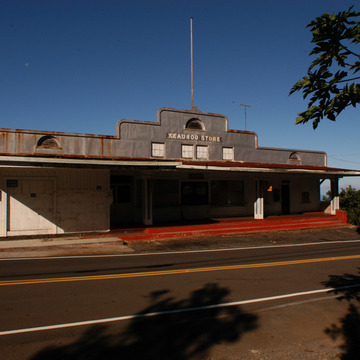This store is distinguished by its galvanized metal, stepped-gable facade and flagpole. Three steps elevate the building above the road, and the consoles supporting the facade-length lanai's corrugated-metal pent roof are embellished with carved chrysanthemum blossoms. The small platform in the right corner of the lanai was used to stack bags of rice, abiding by health regulations which required the bags not sit on the floor.
This general merchandise store served the neighboring community of coffee farmers and also dispensed gasoline to passing motorists. In 1967, the Kuakini highway was extended, diverting much of the traffic that once frequented the store. Rikiyo Sasaki continues to operate this store designed and built by his father, Yoshisuke Sasaki. The elder Sasaki came from a carpenter family in Yamaguchi Prefecture. He had received training as a carpenter in Japan, and in 1907, at the age of twenty-two, immigrated to Hawaii. Here he did some carpentry work, making redwood coffins and water tanks as well as boats and houses. Other nearby structures on which Sasaki worked include Daifukuji Soto Zen Mission (HA9) and the archway at the Tong Wo Tong cemetery. However, his primary business was the successful Keauhou store and its adjoining coffee farm.


